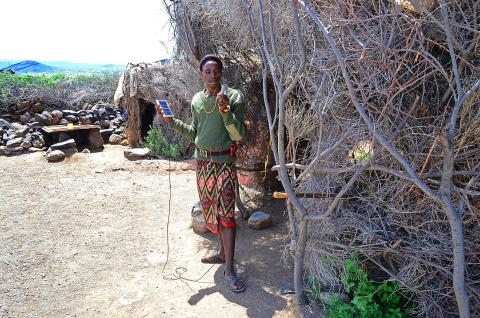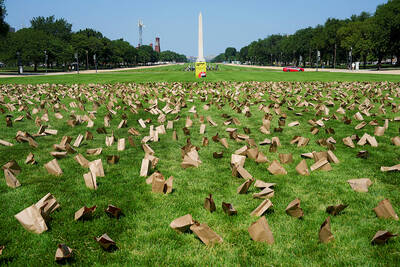Tumbling down to the jade waters below, the rugged hills around Lake Turkana in northern Kenya are made of boulders and lava stone.
This is a remote, lunar landscape and the site of what will one day be Africa’s largest wind farm.
A consortium of European and African companies is preparing to put up 365 wind turbines in a 165km2 stretch of this desolate area inhabited only by semi-nomadic pastoralist herders.

Photo: AFP
As yet, there is little sign of the project. The hills appear untouched by humans, except for nine masts set up to measure the wind that surges between the Kulal and Nyiro mountains.
This wind, which rises over Lake Turkana before dying out over the Sahara, blows at an average speed of 11m per second and is a dream for any engineer working in wind energy.
“In Turkana, the wind speed and also the consistency provides for optimum conditions for wind power — in fact they are better than North Sea offshore wind power,” said Achim Steiner, executive director of the Nairobi-based UN Environment Programme.
“Here you can produce wind power at an interesting cost, without subsidies,” unlike the case in Europe, said Carlo Van Wageningen, chairman of the Lake Turkana Wind Power (LTWP) consortium.
LTWP has entered into a contract to sell the power produced to utility firm Kenya Power over 20 years at a cost of 0.0752 euros (US$0.09) per kilowatt-hour (kWh), a much lower price than that paid for the hydroelectric power mainly used today.
If everything turns out well, the Turkana project will be a poster child for sustainable development — the notion that growth can be clean and improve life for the poor. Green groups, businesses and politicians are heading to Rio de Janeiro this month to give the doctrine a push, culminating with a UN summit on June 20 to June 22.
The project all started when a Dutchman had to continually struggle to stop his tent getting blown away by the wind during a camping trip to Turkana.
He recounted the experience to a compatriot who specialized in wind energy — and so set the ball rolling on seven years of studies, financial negotiations and setbacks. The financial backing is now secured, with only risk guarantees from the World Bank lending agencies Ida and Miga remaining to be finalized.
Once the green light is given on those, potentially by August, then work can begin.
“All the contracts are in place. We’re ready to start,” Van Wageningen said.
The first step would be to build 204km of road to allow trucks to make the 12,000 round-trips needed to deliver all the necessary materials from Mombasa at one end of the country to Turkana at the other. The turbines would be erected in one year, at the rate of one per day, and the first kilowatts of electricity should be delivered to the grid by the end of next year.
By the time it reaches its full capacity, penciled in for the end of 2014, the site will produce 300MW of electricity.
“We will represent about 20 percent of the national electricity production,” LTWP director Chris Staubo said.
The project will cost 585 million euros, plus an additional 142 million euros needed to build 428km of high-tension power lines linking the wind farm with the country’s main power transformer at Suswa.
The African Development Bank is the lead arranger behind a loan covering 70 percent of the enterprise.
The Turkana project is dramatically more ambitious than Africa’s current largest wind farm, located at Melloussa in Morocco with 165 turbines and a capacity of 140MW.
“Kenya is in the midst of pioneering the largest wind power project in Africa and I think, embedded in a green policy of national development,” Steiner said.
“It demonstrates precisely that there is an enormous potential for green energy to succeed in Africa and indeed these projects need to be supported because they break new ground,” he added.
The arrival of the 48m tall wind turbines will radically change the lives of 528 pastoralists — from the Turkana, Samburu, Rendille, Gabra and El Molo tribes — who are still without electricity, running water, telephones, television and even money, relying instead on bartering goods.
LTWP has promised them a 20-year development plan of approximately 1.5 million euros each year. However, they will first temporarily have to shift their village of Sirima to clear the way for the future supply road.
Despite this, local lawmaker Joseph Lekuton said that he was “100 percent with” the project “since the beginning and until the end.”
“The animals will graze where they used to graze,” he said, pointing out that the wind farm would not be fenced off.
For village elder Simon Ekitoe “there will be some good things and some less good things.”
He fears that the arrival of outsiders will bring “new diseases, forced marriages” and that “the women in the village will spurn their traditional dress.”
However, for grandmother Agnes Ngare, with dozens of rings of red beads around her neck and metal earrings dangling from her ears, there is not so much to be worried about.
“I dream that my children and grandchildren will go to school and be able to choose how they want to live their lives,” she said.
“If electricity arrives, that would change my life as I could listen to radio, have a mobile phone and watch television,” she laughed.

Nvidia Corp chief executive officer Jensen Huang (黃仁勳) on Monday introduced the company’s latest supercomputer platform, featuring six new chips made by Taiwan Semiconductor Manufacturing Co (TSMC, 台積電), saying that it is now “in full production.” “If Vera Rubin is going to be in time for this year, it must be in production by now, and so, today I can tell you that Vera Rubin is in full production,” Huang said during his keynote speech at CES in Las Vegas. The rollout of six concurrent chips for Vera Rubin — the company’s next-generation artificial intelligence (AI) computing platform — marks a strategic

Enhanced tax credits that have helped reduce the cost of health insurance for the vast majority of US Affordable Care Act enrollees expired on Jan.1, cementing higher health costs for millions of Americans at the start of the new year. Democrats forced a 43-day US government shutdown over the issue. Moderate Republicans called for a solution to save their political aspirations this year. US President Donald Trump floated a way out, only to back off after conservative backlash. In the end, no one’s efforts were enough to save the subsidies before their expiration date. A US House of Representatives vote

REVENUE PERFORMANCE: Cloud and network products, and electronic components saw strong increases, while smart consumer electronics and computing products fell Hon Hai Precision Industry Co (鴻海精密) yesterday posted 26.51 percent quarterly growth in revenue for last quarter to NT$2.6 trillion (US$82.44 billion), the strongest on record for the period and above expectations, but the company forecast a slight revenue dip this quarter due to seasonal factors. On an annual basis, revenue last quarter grew 22.07 percent, the company said. Analysts on average estimated about NT$2.4 trillion increase. Hon Hai, which assembles servers for Nvidia Corp and iPhones for Apple Inc, is expanding its capacity in the US, adding artificial intelligence (AI) server production in Wisconsin and Texas, where it operates established campuses. This

US President Donald Trump on Friday blocked US photonics firm HieFo Corp’s US$3 million acquisition of assets in New Jersey-based aerospace and defense specialist Emcore Corp, citing national security and China-related concerns. In an order released by the White House, Trump said HieFo was “controlled by a citizen of the People’s Republic of China” and that its 2024 acquisition of Emcore’s businesses led the US president to believe that it might “take action that threatens to impair the national security of the United States.” The order did not name the person or detail Trump’s concerns. “The Transaction is hereby prohibited,”